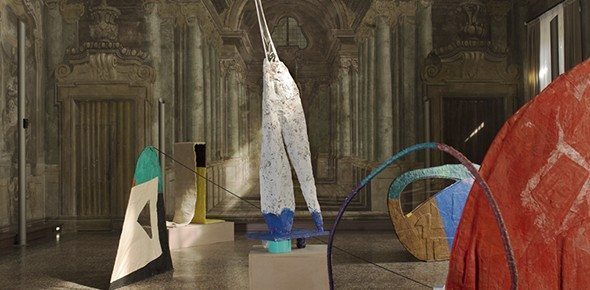Fabienne Lasserre at C.Ar.D. Palazzo Costa Trettenero

Located at No.80 Via Roma, it is one of the most splendid examples of a private building in the Baroque and Rococo style, and was begun in 1690 by Count Giuseppe Costa Trettenero. The palace presents the typical U-shaped configuration of other aristocratic buildings in Piacenza, with a portico running along all three sides and an open scenic garden (formerly in the Italian style, but now styled on an English garden model). The central portion of the façade (mid-eighteenth century), features ashlar plate and is topped by a pediment bearing a coat of arms in relief, and is characterised by three rows of windows with wrought iron balconies and gabled cornices embellished with whimsical swirls. On one of the portico’s three sides a noble staircase – decorated with stucco, frescoes and statues – leads to the hall of honor, which was painted by Ferdinando Bibbiena and Giovanni Evangelista Draghi in 1699. Bibbiena expresses his supreme skill in creating effects that suggest an extraordinary and illusory expansion of space.
Emerging from the hushed, almost sacred twilight of the frescoes by Francesco Galli Bibbiena in the Hall of Honour of Palazzo Costa Trettenero, one encounters the mysterious formal presence of Fabienne Lasserre’s two-dimensional sculptures. Her creations embody something that is both organic and animal, with the contrast of acidic colors against the shadowy walls evoking the image of a small, disquieting horde of aliens who have chosen this magical place to convene.
Fabienne Lasserre, Montreal, 1973. Studied in Montreal, in Mexico City, at the Academy of Prague and at Columbia University; she lives and works in Brooklyn, N.Y. Her art is composed of sculptural paintings that possess both an explosive core comparable to that of volcanic magma, and the ambiguous qualities of the most ancient forms of life. She produces adorable polychrome monsters with tactile skinlike surfaces. Her creativity embodies the infinite potential of a formal expression and a sculptural intelligence that does not fear the concept of the grotesque: she could be defined as a feminine Dubuffet, who has been projected into the world of cartoons and science fiction.
Read full post HERE